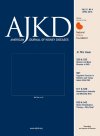Evidence and Renovascular Disease: Trials and Mistrials?
Occlusive renovascular disease presents a vexing challenge. Hypertension induced by renal artery stenosis is among the most widely studied and well-characterized causes of secondary hypertension. When arterial occlusion reaches critical levels, renal blood flow decreases and kidney function eventually deteriorates. It seems intuitive that restoring vessel patency and blood flow should provide clinical benefits both for relieving hypertension and preserving kidney function. This principle was widely accepted in the days of renovascular surgery (mainly in the 1970s) and after wider application of endovascular angioplasty and stenting (in the 1990s).



